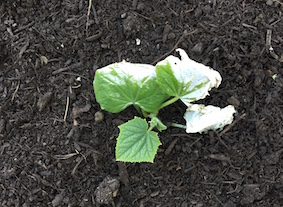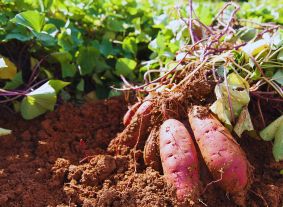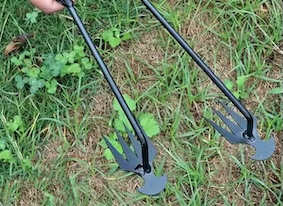White Tissue on Cucumber Plants
Views: 5769

I had some mysterious white tissue develop on my just-planted cucumber plants last week. And I suspect it arose from environmental conditions—and it could be partially my fault, unfortunately.
Except for a few warm days in the upper 70s, spring in New England this year has been cool with many nights and days remaining in the low 50s. Knowing that warm-season vegetables such as tomatoes, cucumbers and squash like both day and night temperatures in the upper 50s, I’ve been holding off putting my summer crops outside in the garden. I grew several pots of each in my indoor seed-raising room this spring where it’s been a lovely 75F.
But alas, due to my schedule and seeing how late in May it was getting, those plants had to get out into the garden. It was a last-minute decision to plant them, meaning I didn’t have time to “acclimatize” them. That is a fancy word to introducing the plants—which had been growing in a lovely and safe 75F indoor environment—into a much cooler outdoor environment with wind and varying light conditions. Acclimation, or getting the plants used to the great outdoors, is usually accomplished over the course of a few days. Place the plants outdoors for a few hours one day and bring them back inside, then the next day leave them a few hours more, and so on until the next step of putting them in the garden 24/7. That was my first misstep.
It was in the low 60s/high 50s when I did plant my tomatoes and cucumbers and squash into the garden. When I was there, it just so happened that my community garden had just received a large delivery of fresh compost. Beautiful stuff! It was still warm to the touch. After planting my plants into the garden I had this great thought: I will put this compost around the base of my plants so its warmth will keep the plants warm. Like wrapping them with a scarf.
Downturn
I went to the garden about two days later and saw large areas of white tissue on just one cucumber plant, radiating from the tip and down the leaf toward the stem. The leaf tissue was dead. What could have happened?
My hypothesis for what happened is heat damage from the still-warm compost. I pushed the compost around the plants so I know just how warm that compost was at the time. I couldn’t have let my hand remain in the compost for more than a few seconds. Maybe, I could have piled the compost too close to these leaves, or it could even have been touching the leaves. The heat could have killed the cells and caused the white tissue to develop.
Bummer! But I am grateful the plant still has that one undamaged leaf. See how it’s a bit smaller and directed upward? That angle of the leaf probably saved my plant. Lesson learned: Be careful with the heat coming out of still-warm compost.
Meet Ellen Wells
When you’re raised on a farm, you can’t help but know a thing or two about gardening. Ellen Wells is our expert on edible gardening.…







